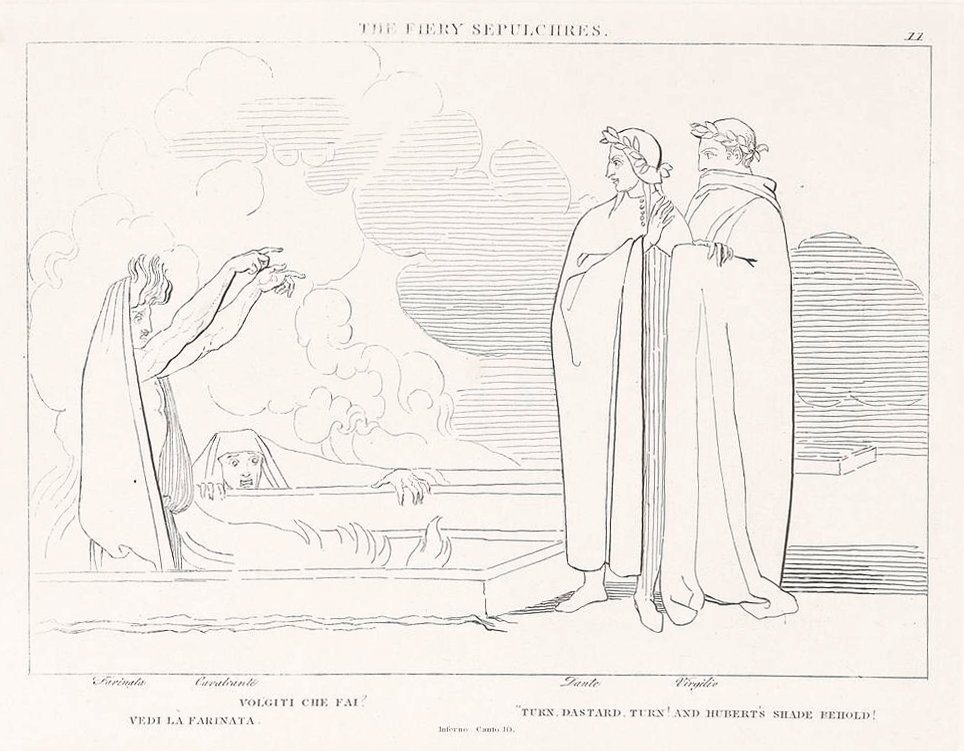John Flaxman

John Flaxman was both a sculptor and illustrator, now best known for his engraved illustrations for classical authors, which were created at the pinnacle of the Neoclassical movement in Europe. These illustrations were first produced during a seven-year period spent in Rome, where Flaxman received a number of major commissions for illustrations of grand literary works, including the Illiad and Odyssey. Art collector and artistocrat Thomas Hope’s 1792 commission was to produce 109 scenes from the Divine Comedy, but unlike the drawings Flaxman produced for the Homeric poems – which were published commercially - these were originally intended for consumption only by Hope’s personal circle. In 1807 however, Hope sold the copper plates Tommaso Piroli had engraved from Flaxman’s drawings to publishers Longman & Co in England, who immediately circulated them as an edition titled Compositions from the Divine poem of Dante.
The publication was notable in as much that interest in Dante’s works among the English-speaking world was minimal during the 18th century. The attraction was only really revived in the late 19th century, once both scholarship and the Romantic imagination began to embrace medieval Italian literature. The translation of the Divine Comedy by the Reverend Henry Boyd, which Flaxman worked from and quoted in his plates, was only the second to have been published in English.
This means Flaxman was likely unfamiliar with any earlier illustrations to the text, such as those by Botticelli and Yates, making his responses to the text entirely novel. His obvious influence was the eminently popular Neoclassical tradition, with naïve renderings inspired by the structure of Roman bas-reliefs (take for instance composition of Count Ugolino Seized or the wrestling figures in Impostors in the gallery below) and proto-Renaissance imagery. A French artist whom Flaxman showed the plates to is recorded as likening them to the work of Fra Angelico.
Flaxman’s drawings proved influential to a number of other Neoclassical artists, including Pinelli, Ingres, and particularly Jean-Louis David. However, in the simplicity of form, treatment of negative space, and a lack of reliance on the extreme emotion present in later versions - for example Doré’s - Flaxman’s take on the material seems fresh and highly modern to today’s eyes.
-

John Flaxman, The Planet Mercury, Compositions By John Flaxman, Sculptor, R.A. From The Divine Poem Of Dante Alighieri, Containing Hell, Purgatory And Paradise, 1807, London : Longman, Hurst, Rees, and Orme. Rare Books, Archives and Special Collections -

John Flaxman, Imposters, Compositions By John Flaxman, Sculptor, R.A. From The Divine Poem Of Dante Alighieri, Containing Hell, Purgatory And Paradise, 1807, London : Longman, Hurst, Rees, and Orme. Rare Books, Archives and Special Collections -

John Flaxman, Count Ugolino Seized, Compositions By John Flaxman, Sculptor, R.A. From The Divine Poem Of Dante Alighieri, Containing Hell, Purgatory And Paradise, 1807, London : Longman, Hurst, Rees, and Orme. Rare Books, Archives and Special Collections -

John Flaxman, Dante's Dream, Compositions By John Flaxman, Sculptor, R.A. From The Divine Poem Of Dante Alighieri, Containing Hell, Purgatory And Paradise, 1807, London : Longman, Hurst, Rees, and Orme. Rare Books, Archives and Special Collections -

John Flaxman, Region of Avarice, Compositions By John Flaxman, Sculptor, R.A. From The Divine Poem Of Dante Alighieri, Containing Hell, Purgatory And Paradise, 1807, London : Longman, Hurst, Rees, and Orme. Rare Books, Archives and Special Collections -

John Flaxman, Tiresias, Compositions By John Flaxman, Sculptor, R.A. From The Divine Poem Of Dante Alighieri, Containing Hell, Purgatory And Paradise, 1807, London : Longman, Hurst, Rees, and Orme. Rare Books, Archives and Special Collections -

John Flaxman, The Virgin Mary, Compositions By John Flaxman, Sculptor, R.A. From The Divine Poem Of Dante Alighieri, Containing Hell, Purgatory And Paradise, 1807, London : Longman, Hurst, Rees, and Orme. Rare Books, Archives and Special Collections -

John Flaxman, Inhabitants of the Moon, Compositions By John Flaxman, Sculptor, R.A. From The Divine Poem Of Dante Alighieri, Containing Hell, Purgatory And Paradise, 1807 London : Longman, Hurst, Rees, and Orme Rare Books, Archives and Special Collections